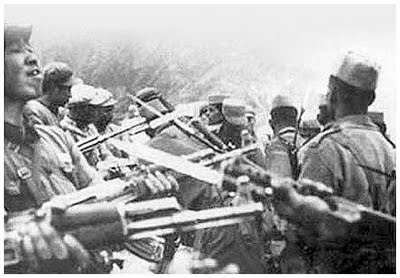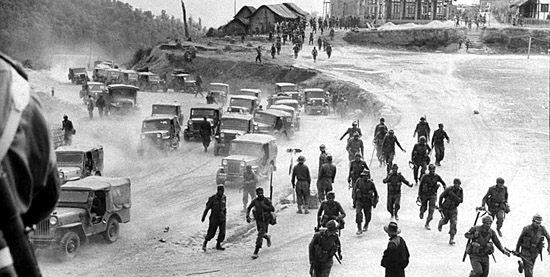Fifty years have passed since the India-China war which commenced on 20th October 1962. The conflict led to momentous changes and overhauls in both the countries. For India the war exposed the cracks in the Armed Forces – a lesson well learnt as demonstrated by the victory over Pakistan in 1965. For China, which was painted as the aggressor mainly due to India’s strategic relations with both the USA and USSR, it was a bitter lesson in international relations. On the fiftieth anniversary of the war Defense minister A K Anthony ruled out the possibility of a repeat of what happened in ’62. But the relationship between India and China is still complicated and is being shaped by a whole new set of factors – the most important ones being economic.

China’s economic growth has been exponential. China has taken the largest number of people out of poverty in the shortest amount of time recorded in history. 77% of China’s population was below the poverty line in 1980 as opposed to just 14% in 2008. The enormity of everything China does is staggering. To put that into perspective, global coal prices fell more than 10% just because China reduced its imports. More than 80% of rare earth metal (semiconductor metals) reserves of the world are in China, by controlling the prices of these, China controls the electronics industry. China has given birth to giants like Huawei and Lenovo. Recently, Lenovo toppled HP as the largest PC maker in the world. By becoming a manufacturing and export hub, China has become indispensible to the world. China has become the driver of the world economy, if China stops, the world will stop.
There are two important aspects to China’s foreign policy – trade and aid. China is already a net exporter to most countries in the world. China holds the largest number of US Treasury bonds held by foreign investors amounting to $1.15 trillion, what this essentially means is that the USA runs on Chinese money. Chinese banks have lent more to developing nations ($110 billion in 2011) than the World Bank ($100 billion). Wen Jiabao has also hinted at Chinese aid to the troubled Eurozone. The trade between China and South Africa has increased to such a level that South African high schools now offer Mandarin courses. Resource hungry China has also invested heavily in rest of Africa especially in oil and mining, thereby influencing the politics of the region.

But there are far more pressing issues closer home. China is investing heavily in infrastructure projects in the sub-continent. Chinese textile companies are investing heavily in Bangladesh. China signed a $1.6 billion agreement to develop the 760-megawatt West Seti Project hydropower plant in Nepal. Chinese construction companies are building Sri Lanka including the Mahinda Rajapaksa cricket stadium. China is also investing in ‘modernizing’ the Sri Lankan army. At the same time India’s bullying of Nepal in the past has given rise to massive anti-Indian sentiment in the Maoist country. India’s relationship with Sri Lanka has similarly been rocky due to the LTTE. There has been a continual increase in Chinese influence in the subcontinent. This is one of the reasons why the US is hailing the only cosmetic changes in Myanmar and trying to setup a base in the sub-continent. The dynamics in the subcontinent are changing and changing fast. India should take heed of these facts because in the event of a future conflict China’s ‘economic’ investments will play a huge role in global perception and alignment.
Fifty years have passed since the India-China war which commenced on 20th October 1962. The conflict led to momentous changes and overhauls in both the countries. For India the war exposed the cracks in the Armed Forces – a lesson well learnt as demonstrated by the victory over Pakistan in 1965. For China, which was painted as the aggressor mainly due to India’s strategic relations with both the USA and USSR, it was a bitter lesson in international relations. On the fiftieth anniversary of the war Defense minister A K Anthony ruled out the possibility of a repeat of what happened in ’62. But the relationship between India and China is still complicated and is being shaped by a whole new set of factors – the most important ones being economic.
China’s economic growth has been exponential. China has taken the largest number of people out of poverty in the shortest amount of time recorded in history. 77% of China’s population was below the poverty line in 1980 as opposed to just 14% in 2008. The enormity of everything China does is staggering. To put that into perspective, global coal prices fell more than 10% just because China reduced its imports. More than 80% of rare earth metal (semiconductor metals) reserves of the world are in China, by controlling the prices of these, China controls the electronics industry. China has given birth to giants like Huawei and Lenovo. Recently, Lenovo toppled HP as the largest PC maker in the world. By becoming a manufacturing and export hub, China has become indispensible to the world. China has become the driver of the world economy, if China stops, the world will stop.
There are two important aspects to China’s foreign policy – trade and aid. China is already a net exporter to most countries in the world. China holds the largest number of US Treasury bonds held by foreign investors amounting to $1.15 trillion, what this essentially means is that the USA runs on Chinese money. Chinese banks have lent more to developing nations ($110 billion in 2011) than the World Bank ($100 billion). Wen Jiabao has also hinted at Chinese aid to the troubled Eurozone. The trade between China and South Africa has increased to such a level that South African high schools now offer Mandarin courses. Resource hungry China has also invested heavily in rest of Africa especially in oil and mining, thereby influencing the politics of the region.
But there are far more pressing issues closer home. China is investing heavily in infrastructure projects in the sub-continent. Chinese textile companies are investing heavily in Bangladesh. China signed a $1.6 billion agreement to develop the 760-megawatt West Seti Project hydropower plant in Nepal. Chinese construction companies are building Sri Lanka including the Mahinda Rajapaksa cricket stadium. China is also investing in ‘modernizing’ the Sri Lankan army. At the same time India’s bullying of Nepal in the past has given rise to massive anti-Indian sentiment in the Maoist country. India’s relationship with Sri Lanka has similarly been rocky due to the LTTE. There has been a continual increase in Chinese influence in the subcontinent. This is one of the reasons why the US is hailing the only cosmetic changes in Myanmar and trying to setup a base in the sub-continent. The dynamics in the subcontinent are changing and changing fast. India should take heed of these facts because in the event of a future conflict China’s ‘economic’ investments will play a huge role in global perception and alignment.